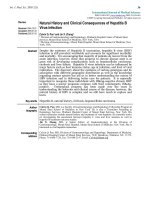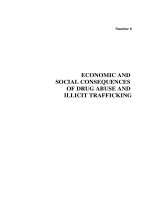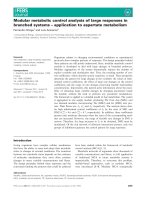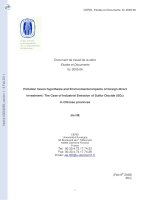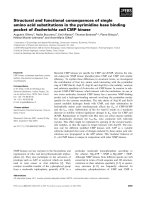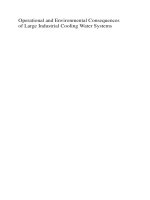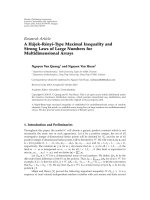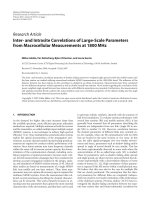operational and environmental consequences of large industrial cooling water systems
Bạn đang xem bản rút gọn của tài liệu. Xem và tải ngay bản đầy đủ của tài liệu tại đây (6.68 MB, 490 trang )
Operational and Environmental Consequences
of Large Industrial Cooling Water Systems
Sanjeevi Rajagopal
●
Henk A. Jenner
Vayalam P. Venugopalan
Editors
Operational and
Environmental Consequences
of Large Industrial Cooling
Water Systems
Editors
Sanjeevi Rajagopal
Department of Animal Ecology
and Ecophysiology
Institute for Water and Wetland Research
Radboud University Nijmegen
Nijmegen, The Netherlands
Vayalam P. Venugopalan
Biofouling and Biofi lm Processes Section
Water and Steam Chemistry Division
BARC Facilities
Kalpakkam, Tamil Nadu, India
Henk A. Jenner
Aquator BV
Wageningen, The Netherlands
ISBN 978-1-4614-1697-5 e-ISBN 978-1-4614-1698-2
DOI 10.1007/978-1-4614-1698-2
Springer New York Dordrecht Heidelberg London
Library of Congress Control Number: 2011943882
© Springer Science+Business Media, LLC 2012
All rights reserved. This work may not be translated or copied in whole or in part without the written
permission of the publisher (Springer Science+Business Media, LLC, 233 Spring Street, New York,
NY 10013, USA), except for brief excerpts in connection with reviews or scholarly analysis. Use in
connection with any form of information storage and retrieval, electronic adaptation, computer software,
or by similar or dissimilar methodology now known or hereafter developed is forbidden.
The use in this publication of trade names, trademarks, service marks, and similar terms, even if they
are not identifi ed as such, is not to be taken as an expression of opinion as to whether or not they are
subject to proprietary rights.
Printed on acid-free paper
Springer is part of Springer Science+Business Media (www.springer.com)
v
Setting the scene and the need for integrated science for the operational and environmental
consequences of large industrial cooling water systems
Industries worldwide have long used and often even abused water: it is a necessary
resource but, by their activities, they have affected the quality of that water and the
health of organisms inhabiting it. In particular, its major use has been as cooling
water required in large amounts by power generation, steel and iron, paper and pulp
and oil industries. These industries abstract water from natural water bodies in very
large amounts, often up to 75 cumecs (m
3
/s)—the fl ow rate of a moderately large
river! The abstracted water often has to be treated with chemicals to combat opera-
tional problems such as biofouling and corrosion. Moreover, the withdrawal and
subsequent discharge of large amounts of water may produce signifi cant impacts on
the receiving water body. Organisms, such as plankton, mobile invertebrates and
fi nfi sh which may be of commercial importance, living in the discharge zone (the
receiving waters) or taken in (impinged and entrained) with the cooling water are
continuously subjected to a combination of mechanical, thermal and chemical
stressors.
There are many ways in which, foremost, human industries affect the natural
aquatic systems and, second, by which the natural systems affect human industries.
We can call the fi rst of these “operational problems”, i.e. the way in which the natu-
ral aquatic system may hinder production by a plant, and the second “environmental
problems” whereby the health of the system, in some way, has been reduced. For
example, for the generation of power using oil, gas, coal or nuclear sources we have
built power plants adjacent to water bodies where that water is used for direct cool-
ing. Those power plants can be regarded as having a behaviour within their environ-
mental systems and so that behaviour requires to be understood. In turn, the natural
system also has a behaviour and so it is also important to understand that behaviour
and the way it affects the natural system. Coupled with these is the need for a good
scientifi c understanding of the ecology of the aquatic system, the hydrodynamics of
the system, and the management and socio-economic system within which the
power plant operates. The latter, therefore, includes the costs of tackling any problems
Preface
vi
Preface
caused on the plant by marine organisms (biofouling) and caused by the plant on the
marine system. Hence, there is the need for a synthesis of the operational and envi-
ronmental issues relating to industrial cooling water systems.
The largest concerns for those involved in either production/operationally related
or environmental-related problems concerning cooling water of these systems are,
Fig. 1 Conceptual Models (Horrendograms) showing the environmental and operational aspects
concerned with the exploration, construction and operation of coastal power plants (the acronyms
used relate to the implementation of European Directives, see McLusky and Elliott
2004 for fur-
ther details)
vii
Preface
fi rst, impingement, defi ned as the trapping of larger material such as fi sh and mobile
invertebrates before they get the chance to pass through the plant. Second, there is
entrainment or the taking into the plant of smaller organisms and the creation of
surfaces for the settlement of those smaller organisms and silts thus even creating a
self-sustaining system within the plant. Third, there is the fate and effects of water
and materials discharged from the plant, especially any thermal plume and its con-
stituents. In addition to heat; we may even get scouring of the seabed adjacent to the
discharge. We can summarise and communicate those aspects as a set of interlinked
features in a “horrendogram”, i.e. a conceptual model showing all the aspects which
need to be considered by operational and environmental managers concerned with
industrial cooling water systems (Fig. 1 ).
As mentioned above, biofouling inside cooling water systems is the result of the
settlement of larval organisms on the surfaces inadvertently provided by the indus-
trial plants. A power plant needs an adequate way of monitoring its surfaces not
least because of the reduction in plant effi ciency or the need to determine if any
antifouling measures have been successful. Hence the cooling water system has to
be designed in relation to the magnitude of the fouling pressure and that design
itself needs to minimise the fouling or produce an easier solution to the problem
once it has occurred.
There is a known sequence of fouling, whereby surfaces are prepared by slimes
and micro-organisms, yeasts etc. which could both increase corrosion, so-called
MIC (microbially infl uenced corrosion), and also makes them mimic normal settle-
ment surfaces; in essence the industrial concrete and metal surfaces acting as a hard
substratum similar to the rocky shore. There then follows a defi ned sequence of
colonisation, with each organism having a preferred set of conditions. For example,
barnacles prefer fast fl owing waters and thus clean surfaces with only a microbial
slime layer, whereas mussels may prefer slower, more turbulent systems and so will
colonise after other organisms have already settled. Hence, there is the need for a
good understanding of the biology of the fouling organisms and the way in which
antifouling measures can control each taxon. An intimate knowledge of the biology
of the fouling organisms is required. For example barnacles require a neighbour to
be adjacent because of their mode of reproduction involving internal fertilisation.
Hence, there is the need to understand the fundamental issues and mechanisms of
microbial fouling and corrosion and thus understand microbial as well as macrobial
systems.
The control of biofouling by chemical means, usually summarised as “chlorina-
tion” and other control methods in industrial cooling water systems is a major issue
for environmental and operational managers. The accepted means of controlling
fouling is by adding biocides, very often oxidising (halogenated) compounds. These
may be added as liquid (sodium hypochlorite), transported into the plant by lorries,
or the chlorine may be produced on-site in specifi c Electro-Chlorination Plants
(ECPs) where the biocide is generated by electrolysis of seawater prior to reinjec-
tion. Hence, there is the need for a good understanding of chlorination chemistry
and the resultant ecotoxicology of the marine cooling water systems (e.g. Taylor
2006 ). Once chlorination is in operation, then the production of organic halogenated
viii
Preface
by-products, e.g. trihalomethanes, chloroform, bromoform, etc., in addition to the
oxidising residuals can create environmental concerns in the receiving waters. Given
the costs of biofouling treatment, yet again affecting the economic viability of the
operation, power plants require technological and economically benefi cial solutions
to biofouling and biocorrosion control as well as environmentally sustainable solu-
tions. For example, by adjusting the timing and magnitude of chlorination, whether
as a pulse or as continuous dosing, in relation to the peak times of settlement by
fouling organisms, a more cost effective and optimal solution can be produced.
The use of biocides is in itself a diffi cult environmental choice because of chlo-
rinated by-product formation where some of the products are listed chemicals which
may be prohibited for discharge. There is then the requirement for ecotoxicological
assessments to determine the scale of those potential problems. Therefore, alterna-
tive methods of cooling are often sought. A rather old-fashioned method is to heat
up the intake/outlet conduits, by plant internal recirculation, where the design of the
plant allows it for heating up the water, the so-called thermoshock method. New
advanced technological methods include the use of “BioBullets” composed of a
toxic compound coated with an attractive nutrient for bivalves on micro scale.
In addition to the operational problems caused by entrainment, operational and
environmental managers are required to address environmental concerns relating to
the organisms entrained, by defi nition those suffi ciently small to get through the
initial screens, often with a mesh of 1 cm
2
, and then into the body of the power plant.
Hence, this includes the permanent members of the plankton, the holoplankton, and
also the dispersing stages of marine organisms, the meroplankton including those of
fi shes (the ichtyoplankton). While there may be billions of such organisms in the
water column and their populations may be spatially and temporally variable, it is
still necessary to detect whether the cooling water intake is having an effect.
However, that inherent variability, what may be called noise in the system, makes it
diffi cult to detect an effect, the signal within the so-called signal-noise ratio.
Following its passage through condensers inside power plants, the discharge of
the cooling water then has the potential for changing the characteristics of the
receiving waters. As mentioned above, this may include the introduction of chlori-
nated by-products but also, and most noticeably, raising the temperature and in
which case those waters become suitable for colonisation by any organisms (invad-
ers) adapted to the conditions. For example, the clam Corbicula uses outlet channels
in winter time as refuge for surviving and, in Southampton Water (UK) a population
of the invasive clam Mercenaria mercenaria has become established near a power
plant discharge. Thus invasive species have implications for industrial cooling water
systems, which provide changed conditions in the receiving waters, for example by
raising the temperature, and then those waters become suitable for colonisation by
any organisms which can tolerate the conditions. Invasive species such as the zebra
mussel Dreissena polymorpha have become a nuisance by settling inside cooling
water systems in large numbers.
After passage through the industrial plant, the cooling water discharge often
produces a thermal plume, in which the water may be 7–10°C higher than ambient.
The characteristics and behaviour of that plume, for example, in either attracting
ix
Preface
organisms or moving over areas of nature conservation importance, become causes
for concern. Of course, if the plume is then entrained by the cooling water intake,
then this is a production problem for the plant which can reduce its effi ciency. The
resultant thermal plume may affect habitats depending on the thermal tolerances of
the organisms and in cases where the receiving areas are of nature conservation
importance then this could lead to breaching of environmental and conservation
regulations. For example, many power plants are in estuaries which include large
intertidal areas which support internationally important populations of wading birds
and juvenile fi shes (McLusky and Elliott
2004 ). Any effects of the plume on either
the invertebrate prey or predators of those sites thus become a cause for concern to
be addressed by environmental and operational managers. For example, given that
many organisms have temperature thresholds which determine times of spawning
increases of temperature could lead to warm-water spawners breeding earlier and
cold-water spawners delaying their reproduction.
Perhaps the most high-profi le effect of power plants and that which attracts most
adverse press coverage is fi sh impingement, the ability of the plant to suck in fi sh and
mobile invertebrates (and weeds and garbage). Indeed this problem may reach such
proportions that we can describe power plants as “stationary trawlers”! The extent of
this depends on fi sh populations in the area, their migrations particularly onshore or
for breeding and at times such as the winter when the power plant and its cooling
system may be working at a maximum (Elliott and Hemingway 2002 ). In addition to
this being a potential problem for the natural populations in the source water areas,
this is also a production problem for the power plant as the impinged fi sh have to be
either returned to the waters, often dead and thus creating both an organic discharge
from the plant and public relations problem of having dead fi sh washed up near the
plant, or disposed of to landfi ll, in itself a costly exercise given that the biological
material is highly organic and thus has the potential to affect watercourses. In some
countries, disposal to landfi ll is taxed and thus expensive for the power plant. Hence,
there is the need to assess the technologies dealing with impingement and disposal of
impinged material and for countries to learn from one another.
As indicated above, there is the need to determine the behaviour of the power
plant and any materials emanating from it within a context of the natural system.
A knowledge of this behaviour will be required as a background to cooling water
discharge guidelines in each country. Such guidelines may follow the “monitoring,
modelling and management” framework—indeed, business would emphasise that
you cannot manage a problem unless you can measure it and you cannot predict the
effects of doing something unless you can model it. Recent advances in numerical
modelling, such as through advanced 3D modelling are therefore important in this
context. There is the need to use numerical modelling to determine the behaviour of
the plume and thus the probability that it will affect certain areas around the plant
and in the receiving waters. There is also the need to measure impingement and
entrainment and, where possible, to model these as a way of providing predictive
support to the designers and managers of cooling water systems.
It is axiomatic that any human activity which has the potential to adversely
affect the natural environment requires permissions. This lies within a legal and
x
Preface
administrative framework, thus including discharge consents, permits, licences and
authorisations and environmental assessments, and requires environmental protec-
tion agencies, nature conservation bodies and ministries of the environment to enact
and police these. Within political blocs such as the European Union, such laws and
regulations may be at a local, regional, national and European level (including the
Water Framework Directive, the Habitats and Species Directive and the Integrated
Pollution Prevention and Control Directive, e.g. Apitz et al.
2006 ). Some of these
are mirrored by the US Clean Water Act and corresponding legislation in many
other countries. Countries are also obliged to follow international obligations such
as the need to protect systems sustainably under the Convention for Biological
Diversity or the UN Conference on Environment and Development. Of course these
follow from the political will in any state to decide if the environmental conse-
quences are suffi cient to outweigh the industrial and social advantages. This regula-
tory and political context is what we may call environmental governance such that
industries such as power plants operate within what is called a PEST environment,
which includes the prevailing political, economic, societal and technological
regime.
Hence by taking together all of the above aspects, we can emphasise that we need
sustainable solutions to the problems created by placing cooling water systems in
natural environments. More importantly, as discussed above, those solutions are
required to be sustainable and hence we take the view that for them to be sustainable
they have to fulfi l “ the 7 - tenets ”—that our actions should be:
Environmentally/ecologically sustainable •
Technologically feasible •
Economically viable •
Socially desirable/tolerable •
Legally permissible •
Administratively achievable and •
Politically expedient (Mee et al. • 2008 )
Each of these aspects requires good and adequate science upon which both oper-
ational (production) management and environmental management can be based.
The science has to be fi t-for-purpose, not least because it is expensive and also the
consequences of unforeseen events may also be expensive. We need the science to
prioritise our need for knowledge—to separate the “nice to know” from the “need
to know” and to determine the cost-benefi t of the work (i.e. what “bang do we get
for a buck”). We need to understand the sequence of understanding (now, mid, long
term), our ability to do it (now, mid, long term) and the applicability of the knowl-
edge (single- or multiple site specifi city). We need to be sure of our basic under-
standing—do we have conceptual models leading to hypothesis generation and
testing leading to what if? and so what? questions; what are the effects of power
plants on marine/estuarine environment and vice versa; what is the impact on domi-
nant processes, structure and functioning—understanding the reliance, resistance,
recovery, hysteresis, etc. of natural systems; do these aspects affect the carrying
capacity of systems—is the carrying capacity reduced for the biota and other human
xi
Preface
activities and exceeded for human activity such as power generation, and fi nally can
we understand the operational and environmental consequences of cooling water
discharges against what we may call the “exogenic unmanaged pressures” such as
climate change.
All of this requires adequate monitoring (including surveillance monitoring,
compliance/condition monitoring, investigative/diagnostic monitoring—see Gray
and Elliott
2009 ) and an understanding of the relative roles and adequacy of survey,
experimental and modelling approaches—especially to understand critical elements
on temporal and spatial scales (in the near and far fi eld/time). We can learn from
elsewhere and thus quantify the level of certainty and uncertainty (what we know
and what we don’t know (“do we know what we don’t know”?)—hence the need for
“Gap Analysis”). We then, of course, need to use this science in management (and
vice versa) by determining measures for mitigation/amelioration/compensation (the
latter of system/habitats/components/users/uses), of defi ning standards/objectives/
indicators and their use/value/applicability. Most importantly, we need to carry out
impact assessments, especially related to legislative requirements, but above all
ensure that our ability to produce “economic goods and services”, such as industry
and power generation, can be maintained while at the same time protecting “eco-
logical goods and services”.
This preface shows the enormity of our task but we have much background infor-
mation on which to build. Previously, there have been attempts to address the opera-
tional issues related to industrial cooling water systems with primary emphasis on
biofouling and its control. Likewise, there have been some attempts to highlight
environmental issues arising out of cooling water intake and discharge. However,
there has been no attempt to comprehensively address the two issues together, even
though they are inextricably linked. This volume aims to integrate two aspects and
present the state-of-the-art knowledge, by bringing together key researchers, each of
whom has been active in this area over recent decades.
England, UK Michael Elliott
References
Apitz SE, Elliott M, Fountain M, Galloway TS (2006) European environmental management:
moving to an ecosystem approach. Integrat Environ Assess Manage 2:80–85
Elliott M, Hemingway KL (eds) (2002) Fishes in estuaries. Blackwell Science, Oxford, p 636
Gray JS, Elliott M (2009) Ecology of marine sediments: science to management. OUP, Oxford,
p 260
McLusky DS, Elliott M (2004) The estuarine ecosystem: ecology, threats and management, 3rd
edn. OUP, Oxford, p 216
Mee LD, Jefferson RL, Laffoley Dd’A, Elliott M (2008) How good is good? Human values and
Europe’s proposed Marine Strategy Directive. Mar Pollut Bull 56:187–204
Taylor CJL (2006) The effects of biological fouling control at coastal and estuarine power stations.
Mar Pollut Bull 53:30–48
xiii
The three of us have been professionally interacting with one another for the past
25 years. However, the idea of editing a book on a subject related to our fi eld of
interest never arose until we received an invitation from Springer. The focus on
operational and environmental issues related to cooling water systems of industrial
plants was an obvious choice not only because of our familiarity with the subject but
also because we felt that there was a shortage of good text books that comprehen-
sively dealt with the complex subject. Having decided on the subject, the task of
apportioning the work to different authors was made easy by the readiness with
which the contributors responded to our request. Their diligence, support, coopera-
tion and, above all, faith in us ensured that we had a comprehensive assortment of
chapters dealing with all important aspects of the issues being discussed. We would
like to thank all the authors for their valuable contributions. We take this opportu-
nity to place on record our deep sense of gratitude to all those who collectively
made it possible for us to bring out this book. The original book proposal was
reviewed by anonymous reviewers, who made some very valuable comments that
encouraged and guided us in this endeavour. We are extremely thankful to Prof.
Michael Elliott, Institute of Estuarine and Coastal Studies, University of Hull for
writing the preface to this book. With the preface, he set the tone and tenor for the
rest of the book and we hope we have been able, at least partly, to bridge the gap that
existed in this important fi eld. Each chapter of this book has been reviewed by at
least two referees. We would like to thank all those anonymous referees for their
critical comments and suggestions, which helped us to improve upon the initial ver-
sions of the manuscripts. We are extremely grateful for editorial support from Peter
Charpentier and Rien van der Gaag of Radboud University Nijmegen, The
Netherlands. The hard work put in by Tulsi Ganesh in transforming the illustrations
and graphs into beautiful fi gures suitable for publication will be gratefully remem-
bered. We are thankful to Prof. Gerard van der Velde, Prof. Sjoerd Wendelaar Bonga
and Dr. Jeroen Jansen for their valuable suggestions and comments. We are particu-
larly indebted to Ms. Melinda (Lindy) Paul, Senior Editor, Environmental Science,
Springer, New York for her help, support, creative comments and immense patience
throughout the editorial process.
Acknowledgements
xiv
Acknowledgements
SR was fi nancially (partly) supported by the Institute for Marine Resources and
Ecosystem Studies (IMARES, Wageningen University, Netherlands), Department
of Animal Ecology and Ecophysiology (Radboud University Nijmegen, Netherlands)
and the European Commission in the Community’s Sixth Framework Programme
(INCO project, Contract number: PL510658, TBT Impacts). VPV is thankful to
Dr. K. V. K. Nair, Dr. S. V. Narasimhan and Dr. S. K. Apte for their support and very
helpful discussions.
S. Rajagopal
H. A. Jenner
V. P. Venugopalan
xv
Sanjeevi RAJAGOPAL, Ph.D., D.Sc.
Dr. Sanjeevi Rajagopal earned his undergraduate (American College, Madurai),
post-graduate (Pachaiyappa’s College, Chennai), M. Phil. (Madras Christian
College, Chennai) and Ph.D. (University of Madras) degrees from India. On being
selected by the Rotary International as the Best Young Scientist for Group Study
Exchange Program, he visited Argentina, Paraguay and Brazil as a Rotary
International Ambassador of Goodwill and Understanding. He joined the Department
of Animal Ecology and Ecophysiology, Radboud University Nijmegen, the
Netherlands in 1994, from where he obtained a D.Sc. degree in 1997. His areas of
research include biofouling control in cooling water systems of power plants in
tropical and temperate countries and analysis of genetic diversity of European
mussel populations using molecular techniques. He has also studied the fi sh diver-
sity changes in tropical mangrove regions of India and the Caribbean. He is an
advisory member of Groupo Ecologista, University of Misiones, Argentina and
member of numerous societies, including the Marine Biological Association of the
United Kingdom and the British Ecological Society. He has published more than
100 scientifi c papers in international journals and is the editor of two books.
About the Editors
xvi
About the Editors
Henk A. JENNER, Ph.D.
Dr. Henk A. Jenner studied biology at the Free University of Amsterdam and did
his Ph.D. in ecotoxicology at the Agricultural University, Wageningen. He worked
more than 30 years at KEMA as researcher, manager and later as senior consultant.
At KEMA, he initiated the research on micro- and macrofouling in cooling water
systems of power generating and other large industries. He is the co-editor of three
books dealing with biofouling and has published more than 100 papers. He was a
principal of a governmental committee (CIW) developing a new and innovative
directive for the discharge of heated effl uents, in tune with the new IPPC and Water
Framework Directive in Europe. His main areas of interest are large-scale industrial
cooling water, modelling of heated cooling water discharge, Legionella problems in
potable water, biofi lm activity monitoring, chlorination & chlorination by-product
formation and environmental impact assessment studies. He retired in 2010.
Vayalam P. VENUGOPALAN, Ph.D.
After obtaining his post-graduate degree in marine biology from the Cochin
University of Science and Technology, Dr. Vayalam P. Venugopalan joined the
National Institute of Oceanography, Goa in 1982. His work on biofouling of offshore
oil platforms in the Bombay High region of the Arabian Sea earned him a Ph.D.
xvii
About the Editors
degree from the University of Bombay. Subsequently, he joined the Bhabha Atomic
Research Centre at Kalpakkam in 1989, where he has been involved in research
relating to biofouling, biofi lms (ecology and biotechnology) and environmental
effects of cooling water discharges. He is currently heading the Biofouling and
Biofi lm Processes Section. Since 1996, he is on the editorial boards of Aquatic
Ecology (as Consulting Editor) and Water Research (as Associate Editor).
xix
1 Operational and Environmental Issues Relating to Industrial
Cooling Water Systems: An Overview 1
Vayalam P. Venugopalan, Sanjeevi Rajagopal, and Henk A. Jenner
2 Biofouling in Cooling Water Intake Systems: Ecological Aspects 13
Sanjeevi Rajagopal and Henk A. Jenner
3 Monitoring: the Underestimated Need in Macrofouling Control 33
Renata Claudi, Henk A. Jenner, and Gerald L. Mackie
4 Cooling Water System Design in Relation to Fouling Pressure 45
Maarten C. M. Bruijs and Henk A. Jenner
5 Barnacles and Their Signifi cance in Biofouling 65
Arga C. Anil, Dattesh V. Desai, Lidita Khandeparker,
and Chetan A. Gaonkar
6 Microbial Fouling and Corrosion: Fundamentals
and Mechanisms 95
Toleti S. Rao
7 Invasive Species: Implications for Industrial Cooling
Water Systems 127
Sanjeevi Rajagopal and Gerard van der Velde
8 Chlorination and Biofouling Control in Industrial Cooling
Water Systems 163
Sanjeevi Rajagopal
9 Chlorination Chemistry and Ecotoxicology of the Marine
Cooling Water Systems 183
Michel Khalanski and Henk A. Jenner
Contents
xx
Contents
10 Biofouling Control: Alternatives to Chlorine 227
Sanjeevi Rajagopal, Henk A. Jenner, Vayalam P. Venugopalan,
and Michel Khalanski
11 Improved Mussel Control Through Microencapsulated
BioBullets 273
Raquel Costa, Geoff D. Moggridge, and David C. Aldridge
12 Pulse-Chlorination
®
: Anti-Fouling Optimization in Seawater
Cooling Systems 287
Iain A. Macdonald, Harry J. Polman, Henk A. Jenner,
and Shahid Q. B. M. Quyam
13 Environmental Impact of Cooling Water Treatment
for Biofouling and Biocorrosion Control 303
Eugene Cloete and Hans-Curt Flemming
14 Effects of Power Plant Entrainment on Phytoplankton 315
Enumula H. Poornima, Velliyur N. Raja Rao,
and Vayalam P. Venugopalan
15 Entrainment of Organisms Through Power Station Cooling
Water Systems 339
Roger N. Bamber and Andrew W. H. Turnpenny
16 Impact of Power Plant Discharge on Intertidal Fauna 353
Sunil Israel, R. Satheesh, Vayalam P. Venugopalan,
Natesan Munuswamy, and Thanumalaya Subramoniam
17 Fish Protection Technologies: The US Experience 371
Gregory Allen, Stephen Amaral, and Jonathan Black
18 Fish Impingement and Prevention Seen in the Light
of Population Dynamics 391
Maarten C. M. Bruijs and Colin J. L. Taylor
19 Cooling Water Discharge Guidelines in the Netherlands:
Recent Developments Through Advanced 3D Modelling 411
Maarten C. M. Bruijs, Henk A. Jenner, and Dju Bijstra
20 Regulatory Aspects of Choice and Operation of Large-Scale
Cooling Systems in Europe 421
Andrew W. H. Turnpenny, Maarten C. M. Bruijs, Christian Wolter,
and Neil Edwards
21 Cooling Water Systems: Effi ciency vis-à-vis Environment 455
Sanjeevi Rajagopal, Vayalam P. Venugopalan, and Henk A. Jenner
List of Contributing Authors 463
Index 467
1
S. Rajagopal et al. (eds.), Operational and Environmental Consequences
of Large Industrial Cooling Water Systems, DOI 10.1007/978-1-4614-1698-2_1,
© Springer Science+Business Media, LLC 2012
1 Introduction
Water is acknowledged to be one of the most essential commodities for almost all
kinds of industrial activity. Among the various industrial uses of water, its use as a heat
removal fl uid is of foremost importance. Thermoelectric generation, which is but one
of the several industries that use water, accounts for more than 50% of all such use.
The industrial use of water, especially in rapidly developing countries, is expected to
grow further and aggravate an already precarious situation concerning availability of
and demand for water. Accelerated growth in the power generation industry alone will
account for a major share of this demand. A typical thermal power plant of 2,000 MWe
capacity, on an average, needs cooling water at the rate of 65 m
3
/s; the requirement
would be about 50% more in the case of a nuclear power plant (Langford 1990 ) .
Most of this water is used for low-energy steam condensation.
The cooling water circuit of an electrical power plant can be of either cooling
tower-aided recirculating or once-through type. In a once-through system, the water
is used for cooling just once, after which it is discharged back into the source water
body. On the other hand, in a recirculating system, a captive volume of water is
repeatedly reused for heat removal. In a typical power plant (nuclear or fossil fuel-
powered), electricity is generated by boiling high purity water to produce high
V. P. Venugopalan (*)
Biofouling and Biofi lm Processes Section, Water and Steam Chemistry Division ,
BARC Facilities , Kalpakkam , Tamil Nadu 603 102, India
e-mail:
S. Rajagopal
Department of Animal Ecology and Ecophysiology, Institute for Water and Wetland Research ,
Radboud University Nijmegen , Heyendaalseweg 135, 6525 AJ Nijmegen , The Netherlands
H. A. Jenner
Aquator BV, Wageningen , The Netherlands
Chapter 1
Operational and Environmental Issues
Relating to Industrial Cooling Water Systems:
An Overview
Vayalam P. Venugopalan , Sanjeevi Rajagopal , and Henk A. Jenner
2
V.P. Venugopalan et al.
pressure steam. The steam is allowed to expand in a turbine, driving a generator and
producing electricity in the process. The steam leaves the turbine and enters the
condenser. The condenser has a large heat transfer surface for effi cient condensation
of the steam using large volumes of cooling water. The condenser removes the heat
of condensation of steam and rejects it directly to the cooling water. This represents
a critical step in the conversion of energy using steam cycle. Decreasing the steam
pressure at the turbine exit is an important strategy for improving steam cycle effi -
ciency. Effi cient heat removal and maintenance of lower condenser pressure require
good circulation of the cooling water. However, water fl ow through the condenser
and consequent heat transfer across the heat exchanger surface are compromised by
biological growth, both on the heat exchanger surfaces (e.g. condenser biofi lm) and
elsewhere in the cooling water circuit (e.g. macrofouling in the pre-condenser
sections, intake systems, conduits, and pipelines Fig. 1.1 ). This constitutes an
important operational problem for the utility. The economic penalties associated
with heat exchanger fouling are generally of the following type: (1) increased capital
costs (due to over-surfacing of heat exchangers and over-sizing of equipment like pumps
and fans, provision for on-line/off-line cleaning equipment, use of specialty materials),
(2) increased maintenance costs (due to increased pressure drop, chemical treatment),
(3) loss of production (due to downtime or operation at reduced capacity) and (4)
energy losses (due to fouling build-up on surfaces) (Bott 1995 ; Raghavan 1996 ) .
2 Operational Problems
Microbial and macroscopic growth on material surfaces is a problem known to man
ever since materials were put to use in the aquatic milieu. Such growth, variously
described as slime, biofi lm, microfouling, macrofouling and biofouling, depending
on the nature of growth and technical background of the person, not only affects
heat transfer properties of the surface but also can considerably impede fl ow and
potentially jeopardize the integrity of the underlying material.
Fig. 1.1 Biofouling on condenser tube sheet heavily fouled ( left ) and relatively clean ( right ) of a
coastal power plant
3
1 Operational and Environmental Issues Relating to Industrial Cooling Water…
Deposition of micro-organisms on metallic surfaces can lead to an increase in the
corrosion rate of these metals. This form of corrosion is called microbially infl u-
enced corrosion (MIC) (Fig. 1.2 ). The economic impact of MIC can be enormous.
For example, downtime for large power stations is often of the order of $1,000,000
per day. In many cases, corrosion-resistant alloys have experienced rapid, through-
wall penetration, when exposed to good quality water from rivers, lakes, estuaries
or ponds—environments that would normally be considered benign. Power plants
have been required to modify, repair, or replace such lines in their entirety. Therefore,
such biological growth on material surfaces is assiduously kept at bay by operators
by resorting to the use of various antifouling techniques. Repair or refurbishment
costs for large nuclear service water systems can be $30,000,000 or more (Licina
and Borenstein
1993 ; Venkatesan and Murthy 2009 ) . Estimations show that 20% of
all corrosion damage in heat exchangers is caused or infl uenced by micro-organisms
(Flemming et al. 2009 ) .
In general, fouling mechanisms, whether biological or non-biological, involve
the following sequences: initiation of fouling, transport to the surface, attachment to
the surface, removal from surface and ageing of deposit (Raghavan 1996 ) . Biological
fouling is generally initiated by the spontaneous adsorption of a layer of organic
substances at the surface (Flemming 2009 ) . As a consequence, a concentration
Fig. 1.2 Kemphase recording of MIC of Cu—Ni alloy tube (by courtesy of KEMA)
4
V.P. Venugopalan et al.
gradient of nutrients is generated at the solid–liquid interface and motile bacteria
are chemotactically attracted to the surface, which initiates the process of surface
colonization. The initial colonizers reinforce their attachment with the help of copi-
ous amounts of exopolymeric substances (Venugopalan et al. 2005 ) . What follows
is a complex process of further attachment of a diverse group of bacteria, cyanobac-
teria, protists, fungi and higher invertebrates. There is evidence for the important
role played by chemical communication among the colonizing species, including
eavesdropping by higher organisms, intent on disrupting the process (Manefi eld
et al. 1991 ; Shiner et al. 2005 ) . With the passage of time, the thin innocuous looking
slime fi lm develops into a formidable biological accretion, consisting of such diver-
sity of organisms as hydroids, polychaetes, barnacles, mussels, oysters and ascidians.
Though the number of species constituting a given biofouling community may be
large, growth in industrial cooling systems tends to be dominated by just a handful
of species (Venugopalan and Narasimhan 2008 ) (Fig. 1.3 ).
3 Biofouling
Biofouling in cooling water systems includes both microbial fouling (especially in
condenser tubes, other heat exchangers and pipe surfaces) and macrofouling (rela-
tively more prevalent in large diameter pipes, screens, pump chambers, etc.). There
is a tendency to consider both these types of fouling together in our approach to
control them. However, it must be emphasized that they need to be treated as two
different but related phenomena and, accordingly, need different approaches and
strategies (Mattice 1985 ) . Microbes and macroscopic organisms tend to respond
differently to biocides, and therefore, biocide type, concentration, dosing frequency
and contact time need to be adjusted accordingly, in order to get best results. For
example, bacteria ensconced in a polymer matrix inside a biofi lm may not be
affected to the same extent by chlorine as a freshly settled invertebrate larva. In the
case of the former, a biodispersant may be required to be dosed to ensure that the
Fig. 1.3 Fouling by green mussels ( Perna viridis ) inside a seawater intake pipe ( left ) and on test
coupons placed in the sea ( right )
5
1 Operational and Environmental Issues Relating to Industrial Cooling Water…
biocide has access to the required target. On the other hand, an adult mussel settled
inside a seawater intake pipe may not be affected by a relatively high dose of chlo-
rine, as long as it can keep its two valves tightly shut (Jenner et al. 1998 ; Rajagopal
et al. 1991 ) .
The distinction between microfouling and macrofouling is important from the
point of view of the economic penalties imposed by them. Microbial slime has the
ability to substantially reduce heat transfer across surfaces, increase pumping costs
due to its visco-elastic nature and enhance corrosion rate of the underlying metal/
alloy by altering the surface electrochemical properties. Macrofouling, on the other
hand, causes blockage of pipes, screens and condenser tubes. It can cause signifi -
cant reduction in the seawater fl ow in intake tunnels and culverts by reducing the
effective diameter and increasing the fl uid frictional resistance (Fig. 1.4 ). Mussel
shells lodged in condenser tubes can cause perforation of the tubes, resulting in
contamination of the boiler feed water by seawater in-leakage and, ultimately, more
serious problems such as boiler corrosion and turbine blade damage. Massive fail-
ure of condenser tubes caused by mussel fouling has been reported from power
stations (Turnpenny and Coughlan 1992 ) . Owing to seasonality in the reproductive
behaviour of higher organisms, macrofouling severity often tends to follow a tem-
poral pattern, which may be less conspicuous in the case of microbial fouling.
A number of factors infl uence the type and extent of biofouling that develops
inside a system. Apart from geographical location, water temperature and local hyd-
robiological characteristics, system-related parameters such as fl ow, substratum and
cooling circuit geometry play important role in the severity of the biofouling prob-
lem (Jenner et al. 1998 ) . It is due to such differences that biofouling tends to be
site-specifi c. Hence, management of macrofouling issues requires certain amount of
fi nesse in one’s approach and quite often it is seen that a given control strategy that
works fi ne at a station is found wanting at a different one.
All the major fouling organisms have free swimming larval stages in their life
cycle, which aid their dispersal and colonisation of new surfaces/areas. The larval
Fig. 1.4 Blockage of the seawater pipe at a power station by biofouling growth
